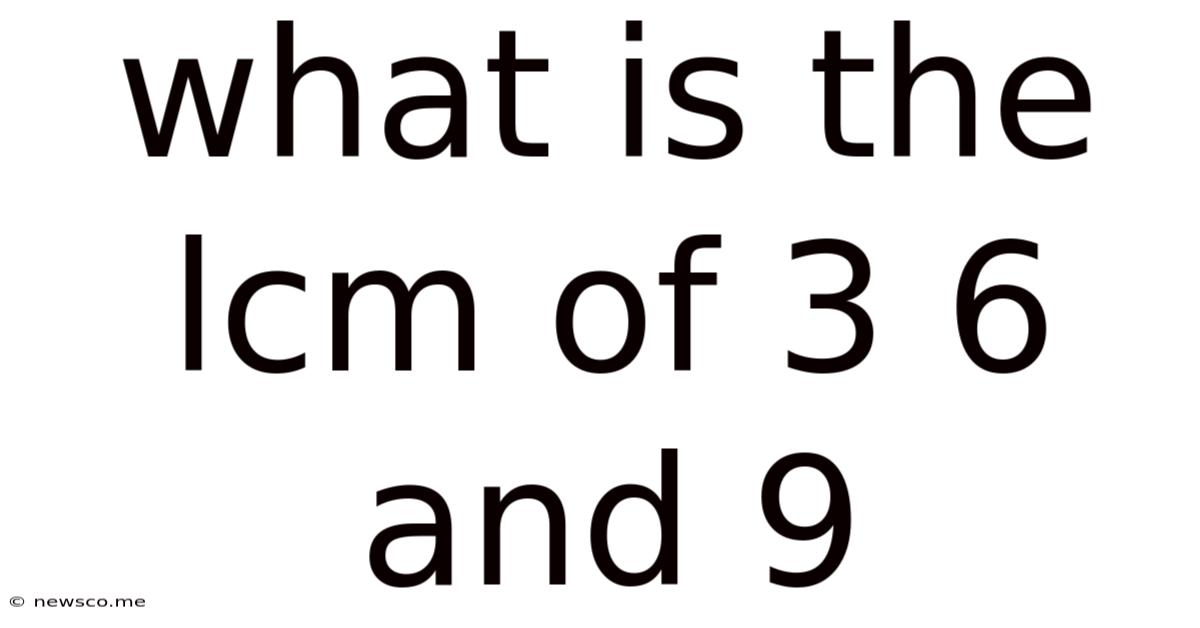What Is The Lcm Of 3 6 And 9
News Co
Apr 22, 2025 · 4 min read

Table of Contents
What is the LCM of 3, 6, and 9? A Deep Dive into Least Common Multiples
Finding the least common multiple (LCM) of a set of numbers is a fundamental concept in mathematics with applications spanning various fields, from scheduling problems to music theory. This article will delve into the process of calculating the LCM of 3, 6, and 9, exploring different methods and providing a comprehensive understanding of the underlying principles. We'll also touch upon the broader significance of LCMs and their practical uses.
Understanding Least Common Multiples (LCM)
Before we tackle the specific problem of finding the LCM of 3, 6, and 9, let's solidify our understanding of what an LCM actually is. The least common multiple of two or more integers is the smallest positive integer that is divisible by all the given integers. Think of it as the smallest number that all the numbers in your set can divide into evenly without leaving a remainder.
For example, if we consider the numbers 2 and 3, their multiples are:
- Multiples of 2: 2, 4, 6, 8, 10, 12, 14, 16, 18...
- Multiples of 3: 3, 6, 9, 12, 15, 18...
The common multiples of 2 and 3 are 6, 12, 18, and so on. The least common multiple is 6.
Method 1: Listing Multiples
The most straightforward method, especially for smaller numbers like 3, 6, and 9, is to list the multiples of each number until you find the smallest common multiple.
- Multiples of 3: 3, 6, 9, 12, 15, 18, 21, 24, 27...
- Multiples of 6: 6, 12, 18, 24, 30, 36...
- Multiples of 9: 9, 18, 27, 36...
By examining the lists, we see that the smallest number appearing in all three lists is 18. Therefore, the LCM of 3, 6, and 9 is 18.
Method 2: Prime Factorization
A more robust method, especially for larger numbers or a greater number of integers, is using prime factorization. This method involves breaking down each number into its prime factors.
-
Prime Factorization:
- 3 = 3
- 6 = 2 x 3
- 9 = 3 x 3 = 3²
-
Identify the highest power of each prime factor:
- The prime factors present are 2 and 3.
- The highest power of 2 is 2¹ (from the prime factorization of 6).
- The highest power of 3 is 3² (from the prime factorization of 9).
-
Multiply the highest powers together:
- LCM(3, 6, 9) = 2¹ x 3² = 2 x 9 = 18
This method provides a systematic approach that works efficiently even with complex numbers.
Method 3: Using the Greatest Common Divisor (GCD)
The LCM and GCD (greatest common divisor) are closely related. There's a useful formula that connects them:
LCM(a, b) x GCD(a, b) = a x b
While this formula is most easily applied to two numbers, it can be extended to multiple numbers through iterative application. Let's first find the GCD of 3, 6, and 9. The GCD is the largest number that divides all three numbers evenly. In this case, the GCD(3, 6, 9) = 3.
We can then use the relationship between LCM and GCD iteratively:
-
Find the LCM of 3 and 6:
- GCD(3,6) = 3
- LCM(3,6) = (3 x 6) / GCD(3,6) = 18/3 = 6
-
Find the LCM of the result (6) and 9:
- GCD(6,9) = 3
- LCM(6,9) = (6 x 9) / GCD(6,9) = 54/3 = 18
Therefore, the LCM(3, 6, 9) = 18.
Applications of LCM in Real-World Scenarios
The concept of LCM extends far beyond the realm of abstract mathematics. It finds practical applications in numerous situations:
-
Scheduling: Imagine you have three different machines that need maintenance. Machine A needs servicing every 3 days, Machine B every 6 days, and Machine C every 9 days. To schedule maintenance so that all three machines are serviced on the same day, you would need to find the LCM(3, 6, 9) = 18. All three machines would be serviced together every 18 days.
-
Music Theory: The LCM is crucial in understanding musical intervals and harmonies. Determining the least common denominator of different note durations helps in composing rhythmically complex music.
-
Fractions: When adding or subtracting fractions with different denominators, finding the LCM of the denominators is essential to find a common denominator for simplification.
-
Project Management: In project management, tasks might have varying completion times. Finding the LCM can help determine the earliest time when all tasks can be completed simultaneously.
Conclusion: Mastering LCM Calculations
Calculating the least common multiple, whether for the simple case of 3, 6, and 9 or for more complex sets of numbers, is a fundamental skill. This article explored three distinct methods: listing multiples, prime factorization, and utilizing the GCD. While the listing method is suitable for smaller numbers, prime factorization provides a more robust and efficient approach for larger numbers. Understanding the relationship between LCM and GCD offers further mathematical insights and alternative calculation paths. Mastering these techniques allows for the efficient solution of various mathematical problems and the effective application of LCM in numerous real-world contexts. The LCM of 3, 6, and 9 is definitively 18, a result easily verifiable through any of the methods described. Remember that choosing the right method depends on the complexity of the numbers involved, but a solid understanding of all methods ensures versatility and problem-solving efficiency.
Latest Posts
Related Post
Thank you for visiting our website which covers about What Is The Lcm Of 3 6 And 9 . We hope the information provided has been useful to you. Feel free to contact us if you have any questions or need further assistance. See you next time and don't miss to bookmark.